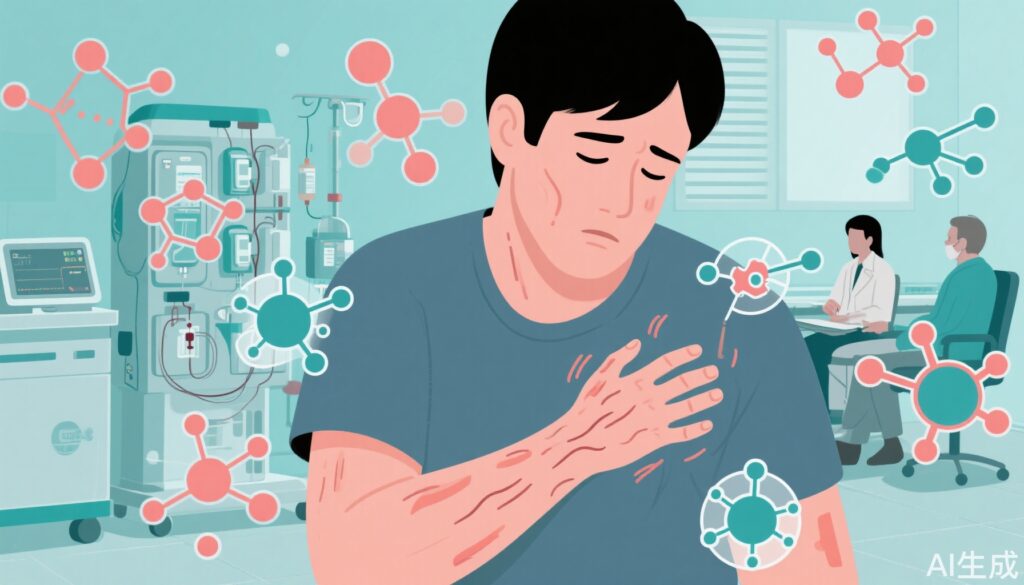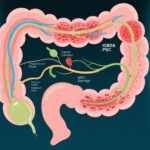Highlight
– CKD-associated pruritus (CKD-aP) is highly prevalent in the dialysis population, affecting up to 85% of patients and often goes underrecognized and undertreated.
– Pathogenesis involves a complex interplay of uremic toxins, metabolic derangements, immune dysregulation, and altered opioid receptor signaling.
– Stepwise management includes optimizing dialysis, topical therapies, systemic agents (gabapentinoids, mast cell stabilizers), and targeted treatments such as opioid receptor modulators and IL-31 antagonists.
– Nemolizumab, an IL-31 receptor antagonist, demonstrates promising efficacy in refractory cases and may shape future therapeutic paradigms.
Background
Chronic kidney disease (CKD) affects an estimated 35 million adults in the United States, with over 808,000 progressing to end-stage renal disease (ESRD). Among CKD patients, dermatologic symptoms are common, and pruritus—defined as an unpleasant sensation that prompts the desire to scratch—is one of the most burdensome. CKD-associated pruritus (CKD-aP) is particularly prevalent in patients on dialysis, with studies reporting a point prevalence ranging from 15% to 49% in chronic renal failure and up to 85% in those receiving dialysis. CKD-aP is linked to poor sleep, reduced quality of life, depression, and even increased mortality risk. Despite this, pruritus remains underreported and undertreated, highlighting a significant unmet clinical need.
Study Overview and Methodological Design
The evidence base for CKD-aP management consists of a mix of observational studies, randomized controlled trials (RCTs), systematic reviews, and recent case series. For example, Murase et al. (2025) reported a multicenter case series of 60 patients with severe, refractory pruritus—including 14 with renal insufficiency—who failed a median of 13 prior therapies and were treated with nemolizumab. Other pivotal studies include systematic reviews evaluating the efficacy of gabapentinoids, and large registry-based analyses (e.g., Rayner et al., 2017) documenting prevalence and reporting patterns among dialysis patients. Outcomes measured across these studies include pruritus intensity (e.g., Numerical Rating Scale), quality of life indices, sleep quality, and adverse events.
Key Findings
– CKD-aP is frequently underdiagnosed: Rayner et al. (2017) found nearly 20% of dialysis patients had not reported itching to any healthcare provider.
– Gabapentin and pregabalin are superior to placebo for CKD-aP but are limited by sedation and dizziness (Shirazian et al., 2017).
– Opioid receptor modulators (difelikefalin, nalfurafine, nalbuphine) show clinically meaningful reductions in pruritus severity, attributed to mu- and kappa-opioid receptor pathway modulation.
– Nemolizumab, targeting the IL-31 receptor, led to clinically significant improvements in 58 of 60 patients (Murase et al., 2025), with a ≥2-point reduction on a pruritus scale or 50% reduction from baseline and a favorable adverse event profile (7.5%; no serious events).
– Non-pharmacologic interventions (cool skin, hydration, avoidance of triggers, optimal dialysis and mineral management) remain foundational but insufficient in refractory cases.
Mechanistic Insights and Pathophysiological Context
CKD-aP pathogenesis is multifactorial:
– Accumulation of pruritogenic toxins (e.g., aluminum, calcium, phosphate, parathyroid hormone) and metabolic imbalances (elevated urea, beta-2 microglobulin, vitamin A, magnesium).
– Systemic inflammation and immune activation, with increased dermal mast cell proliferation and serum cytokines.
– Disruption of skin barrier function (xerosis) and altered neural transmission (uremic sensory neuropathy).
– Dysregulation of endogenous opioid pathways: an imbalance between mu- and kappa-opioid receptor signaling has been implicated, explaining the efficacy of opioid receptor modulators.
– IL-31, an “itch cytokine,” is increasingly recognized as a key mediator in CKD-aP, providing a biological rationale for nemolizumab.
Clinical Implications
Early recognition and systematic management of CKD-aP are crucial. A stepwise approach is recommended:
1. Optimize dialysis adequacy and mineral metabolism (per KDIGO targets).
2. Counsel on non-pharmacologic measures (skin hydration, bathing habits, environmental controls).
3. Initiate topical treatments (emollients, capsaicin, pramoxine).
4. Consider systemic agents (gabapentin, pregabalin) for persistent symptoms.
5. Use targeted therapies (opioid receptor modulators, nemolizumab) in refractory cases.
6. Phototherapy (broadband UVB) may benefit select patients but carries risks.
Validated tools such as the General Itch Questionnaire and Visual Analog Scale should be routinely employed to assess symptom burden, including impact on sleep and mood (Pereira et al., 2019).
Limitations and Controversies
– Many studies are limited by small sample sizes, heterogeneity in patient populations, and reliance on subjective itch scales.
– Placebo response rates are high in pruritus trials, complicating efficacy interpretations.
– Long-term safety and comparative effectiveness of newer agents (e.g., nemolizumab) in CKD/ESRD remain to be established.
– Underreporting and undertreatment persist due to provider and patient barriers, necessitating increased awareness and structured assessments.
Expert Commentary or Guideline Positioning
Current KDIGO guidelines emphasize optimizing dialysis and addressing secondary hyperparathyroidism and hyperphosphatemia as initial steps. Experts advocate for a patient-centered, multidisciplinary approach, with early involvement of dermatology and mental health services in severe cases. Murase et al. (2025) highlight nemolizumab as a promising addition for patients failing conventional therapies.
Conclusion
CKD-associated pruritus is a prevalent, debilitating, and often neglected complication of advanced kidney disease. The evolving understanding of its multifactorial pathogenesis has led to the development of targeted therapies, such as opioid receptor modulators and IL-31 antagonists, which offer hope for improved symptom control. Proactive assessment, individualized treatment, and multidisciplinary collaboration are essential to optimize outcomes. Ongoing research and real-world data will further clarify best practices and inform future guidelines.
References
1. Wang R, Tang C, Chen X, Zhu C, Feng W, Li P, Lu C. Poor sleep and reduced quality of life were associated with symptom distress in patients receiving maintenance hemodialysis. Health Qual Life Outcomes. 2016 Sep 8;14(1):125. doi: 10.1186/s12955-016-0531-6 IF: 3.4 Q1 .
2. Murase EM, Dulai AS, Marzouk S, Lio PA, Sivamani RK, Murase JE. Rapid clinical response to nemolizumab in dermatologic diseases associated with pruritus and burning: A multicenter case series. J Am Acad Dermatol. 2025 Aug;93(2):466-468. doi: 10.1016/j.jaad.2025.03.047 IF: 11.8 Q1
3. Rayner HC, Larkina M, Wang M, Graham-Brown M, van der Veer SN, Ecder T, Hasegawa T, Kleophas W, Bieber BA, Tentori F, Robinson BM, Pisoni RL. International Comparisons of Prevalence, Awareness, and Treatment of Pruritus in People on Hemodialysis. Clin J Am Soc Nephrol. 2017 Dec 7;12(12):2000-2007. doi: 10.2215/CJN.03280317 IF: 7.1 Q1 .
4. Shirazian S, Aina O, Park Y, Chowdhury N, Leger K, Hou L, Miyawaki N, Mathur VS. Chronic kidney disease-associated pruritus: impact on quality of life and current management challenges. Int J Nephrol Renovasc Dis. 2017 Jan 23;10:11-26. doi: 10.2147/IJNRD.S108045 IF: 2.5 Q2 .
5. Pereira, Manuel P. et al. Measurement tools for chronic pruritus: assessment of the symptom and the associated burden: a review, Itch 4(4):p e29, October-December 2019. DOI: 10.1097/itx.0000000000000029 .
6. Aresi G, Rayner HC, Hassan L, Burton JO, Mitra S, Sanders C, van der Veer SN. Reasons for Underreporting of Uremic Pruritus in People With Chronic Kidney Disease: A Qualitative Study. J Pain Symptom Manage. 2019 Oct;58(4):578-586.e2. doi: 10.1016/j.jpainsymman.2019.06.010 IF: 3.5 Q1 .



